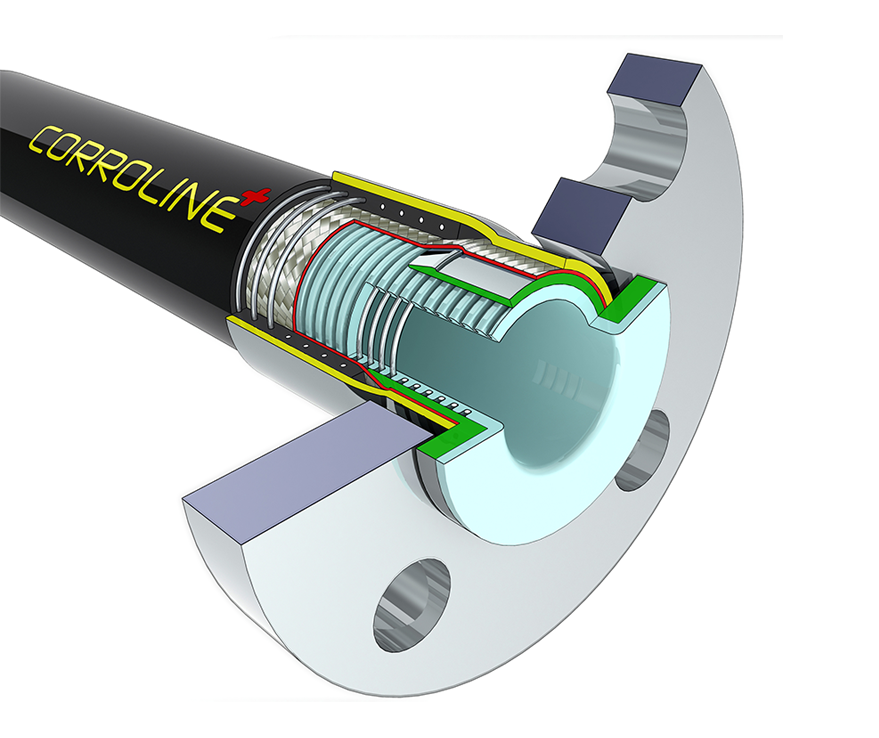Corroline+ Hose |
||||||||||||||||||||||||||||||||||||||||||||||||||||||||||||||||||||||||||||||||||||||||||||||||||||||||||||||||||||||||||||||||||||||||||||||||||||||||||||||||||||||||||||||||||||||||||||||||||||||||||||||||||||||||||||||||||||||||||||||||||||||||||
Like Bioflex Ultra, Corroline+ hose is designed to fulfil all the requirements for use as a chemical hose or industrial hose, but with the added benefit that it has been reinforced to withstand the most severe conditions of physical abuse. Corroline+ is as crush proof and kinkproof as a flexible hose can be, because it is recognized that applications exist in chemical and general process fluid plants where such usage conditions apply.
CONSTRUCTIONIntroductionCorroline+ hose was designed and developed to provide customers with a universal chemical hose product which combined all the requirements they had requested for chemical plant applications, particularly the need for improved flexibility and kink resistance. Corroline+ hose provides a superior alternative to the wide variety of alternative Chemical Hose products currently available. ConstructionCorroline+ is built around a unique PTFE hose liner design, which has a slightly rippled smooth bore inside, but convoluted outside to generate excellent flexibility combined with “hoop strength”. Grade GP hose has a natural (clear) PTFE liner tube and Grade AS hose has an antistatic (Black) PTFE liner tube. A stainless helical wire is wound in to the external convolutions, which adds to the kink resistance, crush resistance and the resistance of the hose to both pressure and vacuum. This reinforced PTFE Liner construction is strong enough to withstand vacuum to -0.9bar and kinking without the need for either internal convolutions or the need to bond the liner to an outer cover, making it an ideal hose liner design, and a significant improvement upon standard products currently available. The PTFE liner is then further reinforced with a 304 SS wire braid. A smooth finish black antistatic EPDM rubber cover is extruded over the braid, which includes a helical reinforcement wire encapsulated in the rubber cover which renders the hose kinkproof. The rubber cover has a mirror smooth surface finish to aid cleaning, and the antistatic rubber is specially compounded to make the hose ‘fireproof’. Corroline+ Hose - The best Flexible Hose for Chemical Plant Applications. Corroline+ GP Hose, fitted with an Integral PTFE Lined Flange Fitting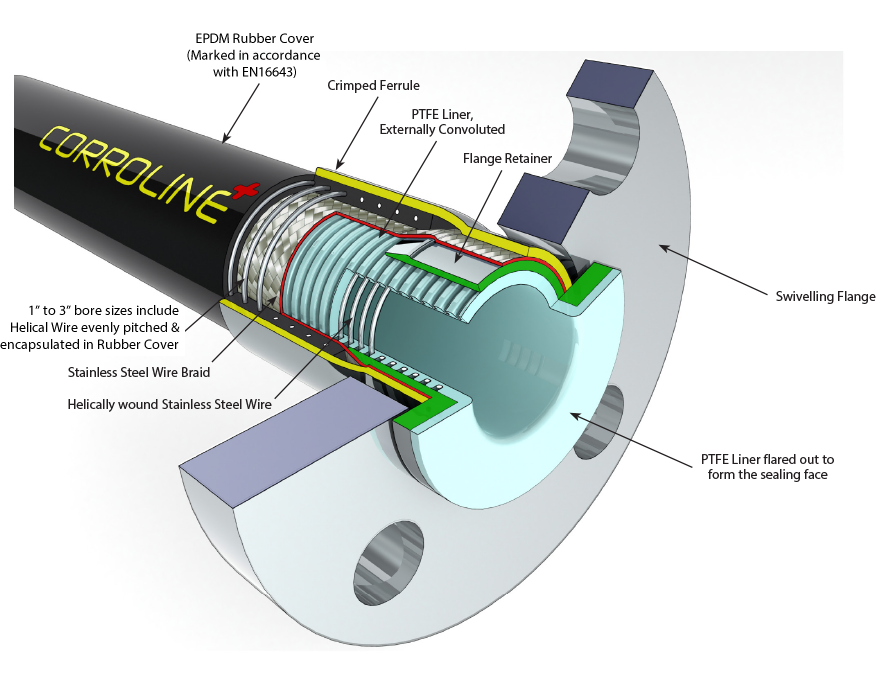
Corroline+ GP Hose, fitted with a Non-lined Flange Fitting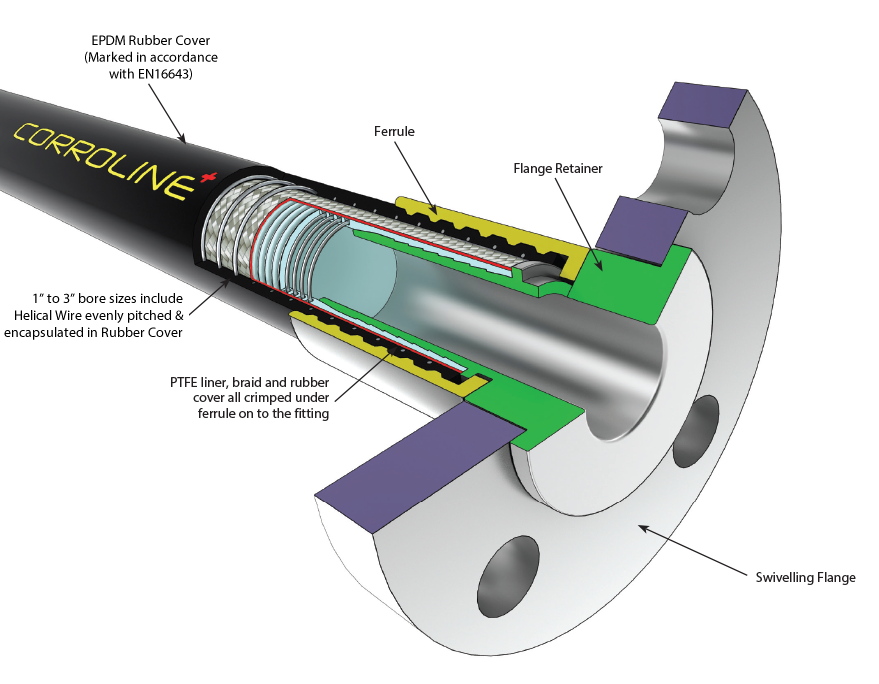
Specification & PropertiesSpecifications for Corroline+ Hose Grades
*The 1/2" and 3/4" size hoses do not include the helical wire embedded in the rubber
Pressure and Temperature LimitationsMaximum Working Pressures - Burst Pressures - Vacuum LimitationsUsable at vacuum to -0.9bar up to 150°C/302°F. FlexibilityMuch less force to bend than any other smooth bore PTFE lined hose product. KinkproofMuch more resistant to kinking than any other smooth bore PTFE lined hose product, and much more kink resistant than the previous Corroline product. Fire resistanceCorroline+ hose is Fireproof to BS5173 Section 103.13 Parts 6.2 and 6.3, and Corroline+ hose assemblies can be upgraded to Fireproof by applying DBK 300 at each end. All assemblies comply with the flammability requirement as set out in EN 16643. ‘Rolling U’ Flex Life TestMore than 100 x the flex life to failure compared with all other types of smooth bore PTFE, FEP and PFA lined rubber covered hose products. Flow ratesMore than 2 times the flow rates for convoluted bore hose designs. Consult Aflex Hose for specific flow rate information. Gas permeabilityReduced gas permeability compared with other PTFE lined hose designs, due to the heavy compression applied to the PTFE during processing, which reduces porosity. Rolling 'U' Test Video
EN16643 Hose Assembly Electrical Property GradesThe hose assembly electrical property grades and electrical resistance limits are defined within EN 16643 and tested in accordance with BS EN ISO 8031. Aflex Hose electrically conductive (EC) assemblies are defined in EN16643 as electrically bonded and given the symbol M. M-grade assemblies exhibit a maximum electrical resistance of 100Ω between end fittings. Aflex Hose anti-static (AS) PTFE liners and rubber covers are termed static dissipative within EN 16643 and given the symbol Ω followed by letters that specify either the liner, cover or both; L=liner, C=cover, CL= cover & liner. Ω-grade covers or liners exhibit an electrical resistance of 103-108Ω. The table below identifies each EN 16643 electrical grade for a hose assembly along with a brief description and example assembly configuration.
How to Order Corroline+ Hose AssembliesCorroline Hose AssembliesCorroline+ hose is custom built into hose assemblies after the hose size and grade, length and end fittings have been selected. The specification and information contained in this brochure can be used to make these selections, but if there are any doubts concerning the hose usage limitations or performance capabilities, customers should request expert advice from Aflex Hose. Selecting the Hose GradeThere are two types of PTFE hose liner tube available, natural (GP) grade and antistatic black (AS) grade, fully described on page 10 If needed there are 3 options for extra protection of the hose against externally applied abrasion and mechanical damage:
Selecting the Hose Assembly LengthThe lengths of Corroline+ hose assemblies are as specified by the customer and the length is measured from the sealing face at one end fitting to the same at the other end of the hose. Length tolerances are normally +5% -0%. Maximum lengths are given under Specifications above Minimum lengths can be calculated from the configuration data on pages 27 - 29 of the PDF Selecting the End FittingsThe range of non-lined standard PTFE tail end fittings and materials are given on pages 12 - 22. Non-lined hydraulic design end fittings are described on page 23 of the PDF. Flange fittings and Cam and Groove fittings are available either non-lined, or with integral PTFE lined and flared ends, see pages 13-15 of the PDF. Corroline+ Hose Liners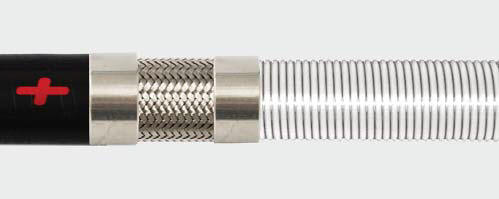
GP - General Purpose LinerPurposeCorroline+ GP is the ‘General Purpose’ grade, for use in all applications where fluids or gases are being conveyed which do not generate a risk of static charge development (see ‘AS’). Materials & SpecificationsCorroline+ GP is a virgin PTFE liner, manufactured from hose grade PTFE which conforms to the requirements of: FDA 21 CFR 177.1550. The helical reinforcement in the convolutions in the liner is High Tensile Grade 316 SS wire. The helical reinforcing wire embedded in the rubber cover is carbon steel. The specially compounded, black EPDM rubber cover is antistatic in accordance with EN ISO 8031 Annex A and the stainless steel braid is grade 304 SS. GP & AS grade approvalsSee Quality Assurances for the full list. 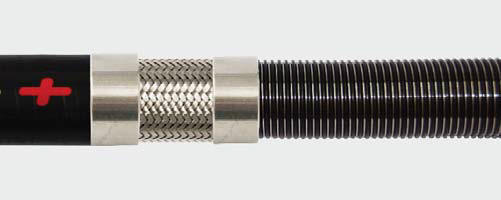
AS - Anti-Static PTFE LinerPurposeCorroline+ AS is an essential requirement in applications where there is the risk of an electrostatic charge build-up on the inside surface of the PTFE tube which may then discharge through the tube wall. Media passing through which create such a risk are fluids which have a Conductance of less than 10-8 S/m (Siemens per Metre), or 104 pS/m such as fuels, solvents, freons, some WFI (ultra-pure ‘Water for Injection’) and non-polar organics which are being transferred at a medium to high flow velocity. All twin or multi phase media, and any non-mixing media, such as powder in air, or water droplets in steam, in gases or in oil, also colloidal fluids constitute a particular hazard for static charge generation, and always require grade AS. If in doubt, consult Aflex Hose. Materials & SpecificationsCorroline+ AS is an anti-static PTFE liner manufactured from FDA 21 CFR 177.1550 approved PTFE, and less than 2.5% of ‘high purity’ Carbon Black material to FDA requirement 21 CFR 178.3297 and European Commission Directive 2007/19/EC. The carbon is encapsulated by the PTFE, and in normal, non-abrasive applications will not come loose to contaminate any fluid passing through. This has been proved during Leachables and Extractables testing. Antistatic Hose AssembliesWhen ‘AS’ (Antistatic) grade hose is specified, then the hose or hose assembly supplied will be tested in accordance with EN ISO 8031 and meet the Antistatic requirements of EN 16643. This requires, for an antistatic liner or antistatic cover, that the resistance between an appropriately placed foam electrode and a metallic end fitting will be between 103 to 108 ohms per assembly. For hose assemblies which meet these requirements an appropriate Grade ‘Ω’ marking is applied in accordance with EN 16643 NOTE: When in service, at least one end fitting must be connected to earth, to permit dissipation of the static charge from the end fitting. 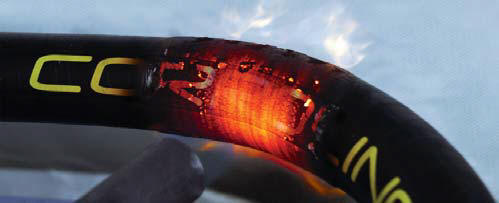
FIREPROOFCorroline+ GP and AS grade hose is Fireproof to BS5173 Section 103.13 Part 6.2 and 6.3. When end fittings are assembled to the hose, the assembly is Fire Resistant, but can be made Fireproof by adding DBK-300 rubber cover end protection. Corroline+ meets the requirements of German safety regulation TRbF 131/2 and EN 16643 flame resistance. SPECIAL NOTE:Electrical Continuity (Also known as ‘Electrically Bonded’) Electrical continuity requires that the hose assembly supplied is electrically continuous, or conductive, between metal end fittings at each end of the hose. This can apply whether the hose is GP or AS grade. The requirements for this are specified in the German Document BRG 132 and EN 16643, when tested in accordance with EN ISO 8031, which requires that the resistance between end fittings shall be <102 ohms per assembly. For hose assemblies which meet this requirement a Grade ‘M’ marking is applied in accordance with EN 16643. Corroline+ Hose Assemblies are all electrically continuous with a resistance of less than 100 ohms. 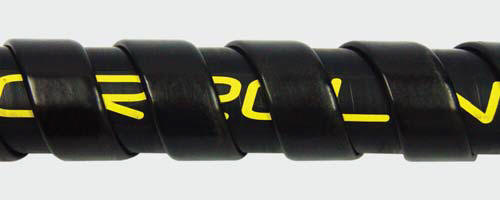
SG - Safegard Protections SleevePurposeTo protect the hose from excessive external abrasion and mechanical damage in rough applications. DesignA lightweight black HDPE (High Density Poly Ethylene) ‘Safegard’ strip is spirally wound along the hose and secured by crimping at each end. LimitationsTemperature Range -40ËšC (-40ËšF) up to 110ËšC (230ËšF). Internal fluid temperatures up to +140°C (284°F) are acceptable, when external temperatures are ambient. The minimum hose assembly length must be doubled if Safegard is being used, and the maximum assembly lengths for all sizes are capped at 20 metres (65 feet). Safegard is available with anti-static properties and complies with the requirements of a static-dissipative cover within EN 16643. Request details upon enquiry. 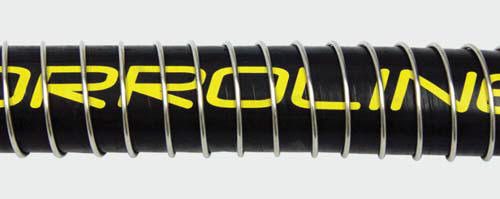
PC - Protection CoilPurposeTo protect the hose from excessive external abrasion and mechanical damage in rough applications without the temperature limitations which apply to the Safegard sleeve. DesignA large diameter stainless steel wire is spirally wrapped on to the rubber cover, and welded to the ferrule at each end. Maximum assembly lengths for all sizes are capped at 20 metres (65 feet) DBK 300 - Double Rubber Cover End Protection
PurposeIn applications where the hose assembly may be mechanically abused by pulling the hose with excessive force at an angle to a connected end fitting. Also to render a hose assembly ‘Fireproof’ by protecting the end fitting area against the effects of fire. DesignA second layer of rubber is applied and vulcanized directly on to the hose and the end fitting ferrule, 12” (300mm) along the hose from the fitting. Labeling & Color CodingStandard Labeling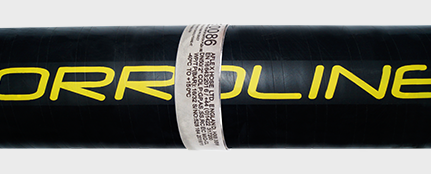
All Corroline+ hose assemblies are labeled with the following information:
This information is normally laser-etched on to a loose stainless steel ring mounted on the hose. In some cases, at the discretion of Aflex Hose, the information may be etched on to a thin stainless steel plate which is clamped to the hose, or on to the end fitting ferrule at one end. This may be necessary for example, if the customer requires additional information which may not fit on to a Ring. Customers may specify which labeling system they require, and may request additional information on the label. Color Coding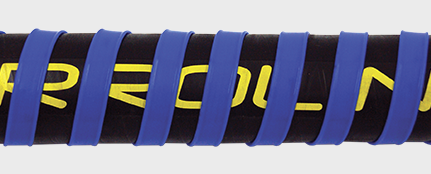
A colored PTFE spiral strip is wound on to the hose. It can be left loose, or it can be encapsulated under a transparent, heat-shrunk polyolefin sleeve. How to OrderCorroline Hose AssembliesCorroline+ hose is custom built into hose assemblies after the hose size and grade, length and end fittings have been selected. The specification and information contained in this brochure can be used to make these selections, but if there are any doubts concerning the hose usage limitations or performance capabilities, customers should request expert advice from Aflex Hose. Selecting the Hose GradeThere are two types of PTFE hose liner tube available, natural (GP) grade and antistatic black (AS) grade. If needed there are 3 options for extra protection of the hose against externally applied abrasion and mechanical damage:
Selecting the Hose Assembly LengthThe lengths of Corroline+ hose assemblies are as specified by the customer and the length is measured from the sealing face at one end fitting to the same at the other end of the hose. Length tolerances are normally -0% +2%. Selecting the End FittingsThe range of non-lined standard PTFE tail end fittings and materials can be viewed in the End Fittings section of our website, or by downloading the brochure. Flange fittings and Cam and Groove fittings are available either non-lined, or with integral PTFE lined and flared ends. Stainless Steel End Fitting MaterialsNon-Lined Spigots - are all made from Grade 316L SS The equivalent specification for the different Grades of Stainless Steel are listed below: Specification Equivalent List
*To special order, end fittings components can be made in non-standard grades of SS such as 1.4571, 1.4435, or other materials such as Hastelloy or Monel How to OrderThe quantity, hose size, grade, length and fittings must be specified in full. Either by a full, written description. The hose grade can be specified by the code initials e.g. ‘Corroline+ AS, SG’ defines an antistatic PTFE lined hose which includes an outer Safegard sleeve. The quantity, length and fittings can then be written in - e.g. “4 off x 1” bore Corroline+ AS, SG hose x 3.00 metres long. Both ends non-lined ANSI 150# S/S Flanges”. or by Part Numbers, as defined in Part Numbers - e.g. 4 off Part No. 16-CLN+AS-SG-3.00m-12-12 Any special requirements relating to the hose construction, or information required on Tags, or Certificates, or special testing requirements, must be specified in full on the enquiry or purchase order. Conditions of SaleCorroline+ hose and hose assemblies are only supplied on the basis that the customer has read and accepted the Conditions of Sale. Customers own Conditions of Sale (or equivalent) are not accepted unless an acceptance signed by a Director of Aflex is supplied.
Part NosIf required, Corroline+ Hose Assemblies can be defined by an individual Part Number, made up of 6 entries as below: 1.
|
||||||||||||||||||||||||||||||||||||||||||||||||||||||||||||||||||||||||||||||||||||||||||||||||||||||||||||||||||||||||||||||||||||||||||||||||||||||||||||||||||||||||||||||||||||||||||||||||||||||||||||||||||||||||||||||||||||||||||||||||||||||||||
| Hose Type | Type Part No |
|---|---|
| Corroline+ GP (Natural PTFE Liner) | CLN+ |
| Corroline+ AS (Antistatic PTFE Liner) | CLN+AS |
3.
| External Protection | Type Part No |
|---|---|
| Double Rubber Cover | DBK |
| Safegard HDPE Sleeve | SG |
| S/S Wire Protection Coil | PC |
4.
| Length |
|---|
| The overall hose length between the sealing faces at each end is given as the Length Part No either in decimal Metres followed by 'm' or inches followed by 'in' |
5 & 6
| Assembled End Fitting Description
* All Components in Stainless Steel N/L = Not PTFE Lined, PTFE/L = PTFE Lined and Flared | End Fitting Part No. |
|---|---|
| N/L JIC Female | 02 |
| N/L Fixed Male Pipe, NPT Thread | 03 |
| N/L Fixed Female Pipe, NPT Thread | 06 |
| N/L JIC-to-NPT Male Union | 08 |
| N/L JIC-to-Female Union | 08F |
| N/L Straight Sanitary Tri Clamp, 50.5mm, 1.984" Diameter
22mm, 0.870" Exit Diameter (Standard) 34.9mm, 1.370" Exit Diameter (Set Up) | 10 10/S |
| N/L Straight Mini Sanitary Tri Clamp, 0.984" Diameter
0.370" Exit Diameter (Standard) 0.625" Exit Diameter (Step-Up) | 11 11/S |
| N/L *ANSI 150# Swiveling Flange | 12 |
| PTFE/L *ANSI 150# Swiveling Flange | 12L |
| N/L Cam and Groove, Locking Arm Swiveling Female | 16 |
| PTFE/L Cam and Groove, Locking Arm Female | 16L |
| N/L Cam and Groove Male | 17 |
| PTFE/L Cam and Groove, Male | 17L |
| N/L DIN 11851 Female | 23 |
| PTFE/L DIN 11851 Female | 23L |
Notes
For Flange only: Add '/ZP' for Carbon Steel Zinc Plated
Elbows: Add '/90' for Non-Lined 90° elbows or, add '/90° L for PTFE Lined 90 ° elbows
Additional Requirements:
- Any additional requirements which are not included in the Part Number must be written out in full in the Order, including any special labelling or colour coding.
- When purchasing Triclovers/Sanitary Fittings please specify the surface finish required.
Example:
A 3/4" bore Corroline+ Hose Assembly with an Antistatic PTFE Liner and an outer Safegard Sleeve with:
End (1) - a 3/4" ANSI 150# Swivel Flange, PTFE Lined
End (2) - a Cam and Groove Swivelling Female, PTFE Lined
and a Length of - 2.35 metres
Hose Assembly Part No. = 12 - CLN+AS - SG - 2.35m - 12L - 16L
Entry No. 1 2 3 4 5 6
Quality Assurances
BS EN ISO 9001:2008
Aflex products are all manufactured in accordance with BS EN ISO 9001 Quality Management Systems independently assessed and registered by The British Standards Institution (BSI).
EN16643
Corroline+ meets the requirements of EN 16643 (type SC), which include the electrical and electrostatic requirements of hose assemblies.
TS16949
Aflex Hose Ltd manufactures PTFE flexible hose for the automotive industry in accordance with TS16949 and is assessed and certified by The British Standards Institution (BSI).
ISO 14001:2015
Aflex Hose Ltd have been successfully assessed to the requirements of ISO 14001, by the British Standards Institution (BSI). By gaining this accreditation Aflex Hose Ltd are demonstrating our commitment to reducing our impact on the environment.
USP Class VI and ISO 10993-5, 6, 10 and 11 guidelines
Natural and Antistatic PTFE Hose Liners, Platinum Cured Silicone Rubber Covers (White and Clear) and EPDM Rubber Cover (Blue) have been independently tested in accordance with USP protocols and are found to conform to the requirements of USP Class VI Chapter <88>.
Natural and Antistatic PTFE Hose Liners now also meet the more stringent USP Class VI and ISO 10993-6,10 and 11 guidelines at 121°C (250°F) with a “no reaction” classification.
Natural and Antistatic PTFE Hose Liners and Platinum Cured Silicone Rubber Covers (White and Clear) have also been tested in
accordance with USP protocols and are found to conform to the requirements of USP Class VI <87>, the L929 MEM Elution Test and are considered non-cytotoxic.
Natural and Antistatic PTFE Hose Liners have now been further tested and have passed the more stringent USP Class VI and ISO 10993-5 guidelines at 121ËšC (250ËšF).
USP <661> Physicochemical Test for Plastics
Natural and Antistatic (Carbon filled) Externally Convoluted Smoothbore PTFE hose has been tested in accordance with USP
Physicochemical Test for Plastics and found to meet the criteria of the following reference: USP34, NF 29, 2011. Monograph <661> Containers, Physicochemical Test-Plastics.
FDA
The Materials used to manufacture the natural PTFE Tube liner conforms to FDA 21 CFR 177.1550, and the antistatic PTFE liner conforms to FDA 21 CFR 178.3297.
BPSA leachables and extractables testing
Aflex Hose Natural and Antistatic PTFE Hose Liner Tube has been independently tested in accordance with BPSA recommendations, and found to be satisfactory.
Copies of the Test Report are available for specific assessments to be made.
Flame Resistant
To special order only, Aflex Hose are able to supply hose with a special rubber cover which is compliant with the requirements of EN 45545, DIN 5510 and NFF 16101 specifications.
Pharmaceutical and Chemical Manufacturers Approvals
Most of the major pharmaceutical and Chemical manufacturing companies in the world have audited and/or approved Aflex Hose as a Hose Supplier.
CE Marking (Europe only)
Aflex has been assessed by The British Standards Institution (BSI) and found to comply with the Pressure Equipment Directive 2014/68/EU Conformity Assessment Module D1, approved to CE Mark applicable hose products, accompanied by a Hose Usage Data Sheet, and a Declaration of Conformity.
Attestations of Conformity to ATEX Directive 2014/34/EU (Potentially Explosive Atmospheres)
Available for hose assemblies for components used in Gas Zones 1 & 2 and Dust Zones 21 & 22,
when applicable.
Material Certification to EN10204
Available for all the hose or hose assembly components.
Certificates of Conformity to BS EN ISO/IEC 17050
Are available for all products.
Hose Testing
Each assembly is pressure tested to 2.0 times maximum working pressure before despatch, and pressure test certificates can be supplied.
Fire Resistance to BS5173 Section 103.13 Part 6.2 and 6.3
RC Grade Corroline+ hose assemblies are “Fire Resistant”. If DBK-300 is added at both ends, the assemblies are upgraded to “Fire Proof”.
Food Contact
Manufactured in compliance with Regulation (EC) No 1935/2004 - on materials and articles intended to come in to contact with food, Commission regulation (EU) No 10/2011 - relating to plastic materials and articles intended to come into contact with food and Regulation (EC) No 2023/2006 - on good manufacturing practise for materials and articles intended to come in to contact with food.
Special Usage Conditions
Cleaning & Sterilising Systems - CIP, SIP and Autoclave
CIP & SIP PTFE liner tubes are chemically resistant to all CIP, SIP and Autoclave conditions. A primary consideration is whether the cleaning and purging cycle is likely to develop an electrostatic charge on the internal surface of the liner, in which case AS (Anti-Static) grade hose is required.
AS grade hose and Electrostatic charge generating systems are fully described in the hose liner section.
CIP systems using high electrical resistivity solvents like Toluene will require AS grade hose.
Another electrostatic generation problem arises when wet steam is passed through, or when the cleaning fluids or WFI are purged out of the line using nitrogen, compressed air or another gas, because droplets of liquid or water in the gas then generate a multi-phase condition until they are cleared out, which will generate a static charge, and so will require AS grade hose.
Autoclave
Corroline+ hose is able to withstand at least 100 x 30 minute autoclave cycles at relatively high autoclave temperatures (up to 135°C, 275°F). Consult Aflex Hose for more specific information.
PTFE Hose-Use with Alkali Metals, Halogens and certain Halogens
containing Chemicals
PTFE hose liners react chemically with Fluorine, Chlorine Trifluoride and molten Alkali Metals and so no hose grades are suitable for use with these chemicals.
When PTFE lined hose is used to carry Chlorine or Bromine, either as gasses or fluids, trace quantities can diffuse into and through the PTFE liner wall thickness. These will then combine with atmospheric moisture to corrode the SS braid or rubber cover outside the liner tube. It has been found that Corroflon SP, HB or KYB hose is best suited for these applications - Please consult the Corroflon brochure.
Depending upon the internal pressures and temperatures, some other gasses and fluids with a high halogen content may also be transmitted in trace quantities through the wall of the PTFE tube, including Hydrogen Fluoride, Hydrogen Chloride, Carbonyl Chloride (Phosgene), Carbon Tetrachloride and others. Please consult with Aflex Hose for a suitable hose grade recommendation.
Other “Penetrating” Fluids and Gases
Sulphur Trioxide, Methyl Methacrylate, Caprolactam and Glacial Acetic Acid are some other chemicals which do not react chemically with the PTFE, but which can be absorbed and transmitted in trace quantities through the PTFE liner tube wall - please consult Aflex Hose for the optimum solution with these chemicals.
Generally, however, as a hydrophobic (non-wetting) material, PTFE is very resistant to the absorption of chemicals. In some cases, PTFE has superior resistance to diffusion, for example to the diffusion of automotive fuels, in comparison with all other plastics and rubbers.
Gas/Fluid Cycling
There are some applications where fluids then gasses are passed through the hose, in a cyclic sequence.
This is normally associated with changes in temperature and/or pressure. For complex reasons these conditions are extremely damaging to the hose liner, whatever material it is made from.
For example, hoses are sometimes used to pass steam, water, steam etc into rubber moulding presses, in order to heat the mould, then rapidly cool it before reheating in the next cycle. Hoses of all types fail rapidly in such an application and PTFE lined hoses are no exception.
Please contact Aflex Hose for further information if these conditions apply.
Connecting Assemblies for Use in Applications
The lengths of hose assemblies and their configuration in use when connected into the application must always be in accordance with the Hose Configuration information at the end of this product literature.
When being connected for use in applications, the end fittings on hose assemblies must be connected to correct mating parts in the correct way, using the correct tools, spanners, clamps, nuts and bolts etc. The connections must be sufficiently tightened to ensure that the joint is leak free but not be over tightened as this can damage the sealing surfaces, especially with PTFE lined and flared end fittings.
In applications involving the transfer through the hose of expensive or dangerous fluids or gases, the hoses and connections must be pressure tested in situ before being put in to service. This should be done with some harmless media to 2.0 times times the maximum working pressure of the hose assembly, as stated in the product literature.
If in doubt please contact Aflex Hose for advice.
Special Applications
Aflex Hose PTFE lined hose products are not rated as suitable for use in the following, special applications:
- All Radioactive Applications involving high energy radiation, including Gamma radiation
(degrades PTFE) - All Medical Implantation Applications.
- All Aerospace Applications, except by special prior agreement, confirmed in writing.
Silicone-Free Application requirements
Some applications, particularly paint manufacturing plants, and other specialised applications require that hoses do not include any silicone containing materials in their manufacture, or sometimes that hoses are guaranteed to be 100% Silicone Free. Customers or Distributors must specifically identify and define any such requirements in writing on all enquiries/orders.
Configure for Bend Radius
Hose Configuration Requirements
Hose Assemblies are usually connected at both ends in service. They may then either remain in a fixed, or static configuration or in a flexing, or dynamic configuration.
Whether static or dynamic, the First Rule concerning the configuration of the hose is that the bend radius of the hose must never be less than the Minimum Bend Radius (MBR) for the hose as listed in the relevant hose brochure.
The most common situation when this is likely to occur is when the hose is flexed at the end fitting, with stress being applied to the hose at an angle to the axis of the end fitting. Typically, this happens either because the length of the hose is too short, or because the weight of the hose plus contents creates a stress at an angle to the end fitting.
The Second Rule, therefore, if possible, is to design the configuration to ensure that any flexing in the hose takes place away from the end fittings.
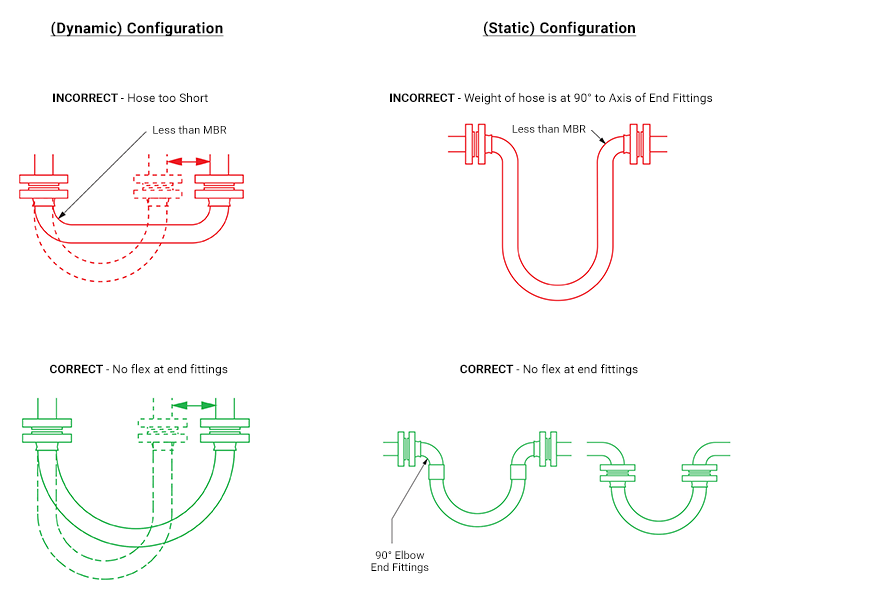
Configure for Abrasion & Torque
The Third Rule is that the hose configuration should always be designed, and supported where necessary, to avoid any possibility of external abrasion.
In some cases, the length, configuration and angle of the hose can be designed to avoid abrasion. In others, static or moving support frames or support wheels are required.
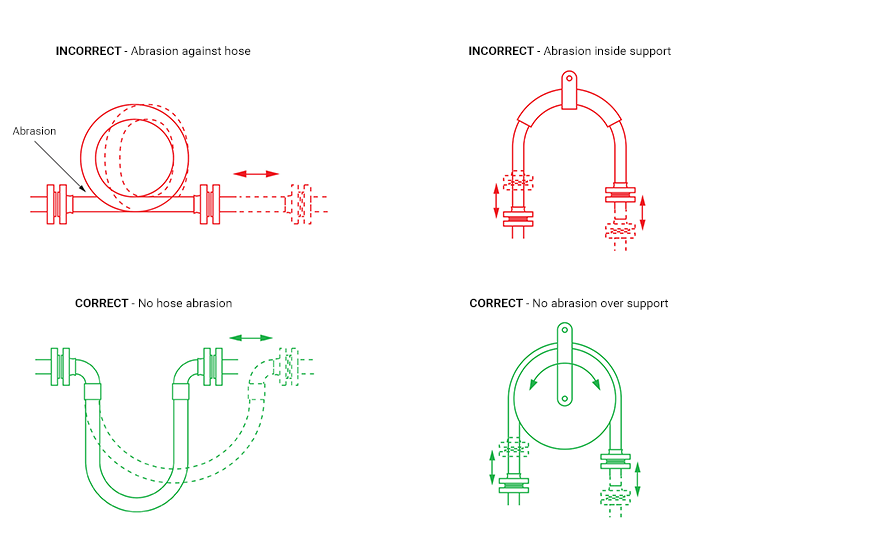
The Fourth Rule is that the hose must not be subjected to torque, either during connection, or as a result of the flexing cycle.
Torque (twist) in the hose can be applied during connection if the hose is accidentally twisted, or if the second end being connected is a screwed connection, and the hose is subjected to torque during final tightening.
In a flexing application, if any flexing cycle of the hose occurs in 3 dimensions instead of 2, then torque will also occur:
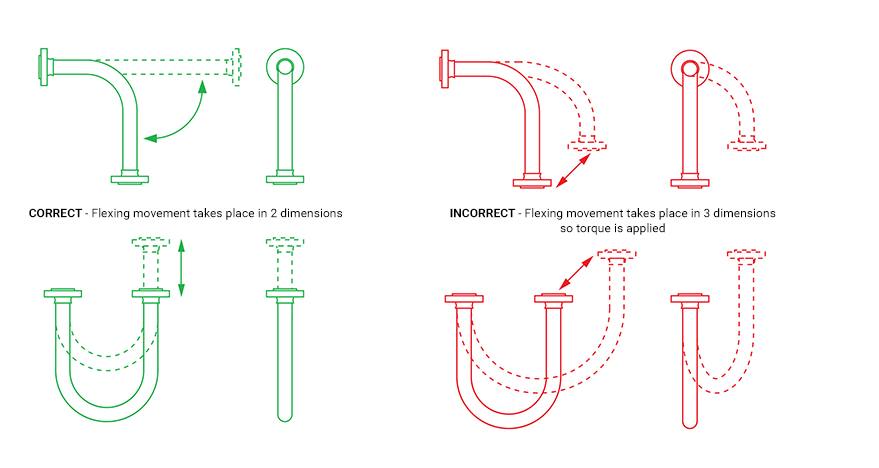
Length Calculation
Calculating the Hose Length
The formula for calculating the bent section of the hose length around a radius is derived from the basic formula that the circumference of a circle = 2ΠR, where R = the radius of the circle, and Π = a constant, = 3.142.
So, if the hose goes around a 90° bend, which is 1/4 of a full circumference, and the radius of the bend is R, then the length of the hose around the bend is = 1/4 x 2ΠR. Or half way round, in a U-shape,
= 1/2 x 2ΠR.
Note: In calculating the length of a hose assembly, the (non-flexible) length of the end fittings must be added in, also the length of any straight sections of hose, as in the following example:

Example:
To calculate the length for a 2” bore size hose with flange end fittings, to be fitted in a 90° configuration with one leg 400mm long, the other 600mm long.
Length of Bent Section (yellow) = 1/4 x 2ΠR (334) = 1/4 x 2 x 3.142 x 334 = 525mm
Length of top, Straight Section, including the top end fitting length = 600 - 334 = 266mm
Length of bottom end fitting = 66mm
Total length of Hose Assembly = 525 + 266 + 66 = 857mm

Things to consider
- A hose will normally take the longest radius available to it to go around a corner, not the MBR! Also - always remember to include the non-flexible end fitting lengths.
- In dynamic applications, remember to always calculate the lengths for the most extended configuration during the flexing cycle, not the least extended.
- If the configuration is simply too complex for calculation, then obtain a length of flexible tubing of some kind, mark on paper, or a wall, or floor, or both where the connection points will be relative to each other, scaled down if necessary, then manually run the flexible tubing between them with full radii round bends. Measure the extended length, then scale up if necessary to determine the approximate length of the hose.
If in doubt, consult Aflex Hose.
Our Commitment to Quality
Above all else, Carolina Components Group is committed to producing components of the highest quality.
Our customers can be assured that the products that they receive meet their stringent quality standards.
Carolina Components Group is a Member or Affiliate of:



